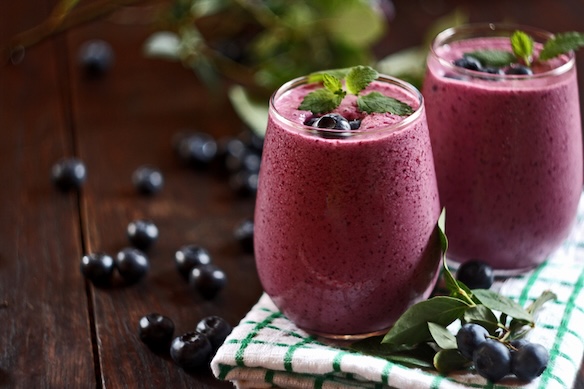Smoothies are a popular choice for people who want a quick, portable, and nutrient-dense meal or snack. While they can be a fantastic way to pack in vitamins, minerals, and protein, many store-bought and homemade smoothies are loaded with sugar—sometimes more than a can of soda. By focusing on low sugar, high protein smoothies, you can enjoy sustained energy, balanced blood sugar, and better support for weight management and overall health.
This article explores the benefits of a low sugar, high protein diet, the difference between natural sugars and added sugars, delicious recipes, common sugar traps to avoid, and how Evidation can help you track and reach your nutrition goals.
Benefits of a Low Sugar, High Protein Diet
Reducing added sugar and prioritizing protein in your diet has a wide range of health benefits, including:
- Stable blood sugar and energy: Diets high in sugar can cause sharp spikes and crashes in blood sugar. This often leaves you feeling fatigued, irritable, and hungry soon after eating. A smoothie with limited sugar and plenty of protein helps prevent these swings, keeping your energy more consistent throughout the day.
- Weight management: Protein is known for its satiating effect—it helps you feel full longer. Pairing protein with low sugar content can reduce cravings and prevent overeating, making it easier to maintain or lose weight.
- Muscle recovery and growth: Protein is essential for muscle repair after workouts. A smoothie with high-quality protein but minimal sugar supports exercise recovery without unnecessary empty calories.
- Reduced risk of chronic diseases: High sugar diets are linked to obesity, type 2 diabetes, and heart disease. Choosing smoothies that are low in sugar but high in nutrients may help lower your risk for these conditions.
Natural Sugars from Fruits vs. Adding Sugary Products
It’s important to understand that not all sugars are created equal. Whole fruits such as berries, apples, and bananas contain natural sugars along with fiber, vitamins, and antioxidants. When blended into a smoothie, they offer sweetness plus nutritional benefits. The fiber in fruit helps slow down digestion, preventing the rapid blood sugar spikes often seen with processed sugar.
Many smoothie recipes include sweetened yogurts, flavored almond milk, honey, syrups, or even ice cream. These additions can drastically increase the sugar content without providing much in the way of nutrition. For example, flavored protein powders or sweetened plant milks can add 10–20 grams of sugar per serving.
Awareness is key — the goal isn’t to eliminate sugar, but to reduce and balance it. Opting for fruits lower in sugar—such as strawberries, blueberries, or raspberries—keeps the sweetness without overwhelming the drink. Pairing fruit with protein (such as Greek yogurt, cottage cheese, or protein powder) and healthy fats (such as nut butter or chia seeds) makes a smoothie both satisfying and nutritionally balanced.
Low Sugar Smoothie Recipes for Energy
These recipes emphasize natural, slow-releasing energy rather than quick sugar spikes. Each one is rich in protein and designed to keep you alert and fueled.
1. Green Power Protein Smoothie
- 1 cup unsweetened almond milk
- 1 scoop unflavored or low-sugar protein powder
- 1 handful spinach
- ½ small avocado
- ½ cup frozen pineapple (adds natural sweetness)
- 1 tbsp chia seeds
This smoothie blends leafy greens with healthy fats and a modest amount of pineapple for a tropical taste. The avocado provides creaminess and satiety without spiking blood sugar.
2. Berry Almond Energy Shake
- 1 cup unsweetened almond milk
- ½ cup frozen blueberries
- ½ cup frozen raspberries
- 2 tbsp almond butter
- 1 scoop vanilla protein powder (unsweetened)
Berries are lower in sugar compared to tropical fruits, and the almond butter adds sustained energy from healthy fats and protein. This makes it perfect for a mid-morning pick-me-up.
Low Sugar Smoothie Recipes for Weight Loss
If your goal is weight management, the following smoothies prioritize high protein, low sugar, and controlled calories while still being filling.
3. Chocolate Peanut Butter Slim Smoothie
- 1 cup unsweetened almond milk
- 1 scoop chocolate protein powder (low sugar)
- 1 tbsp natural peanut butter
- 1 tbsp cocoa powder
- 1 handful ice cubes
This smoothie tastes indulgent but avoids hidden sugars by using unsweetened cocoa powder. The peanut butter and protein powder provide a balance of protein and healthy fats, keeping you full for hours.
4. Cinnamon Apple Pie Smoothie
- 1 cup unsweetened oat milk
- ½ small apple, chopped
- 1 scoop vanilla protein powder (unsweetened)
- 1 tsp ground cinnamon
- 1 tbsp ground flaxseed
With fiber from apples and flaxseed, this smoothie keeps digestion steady and prevents hunger spikes. Cinnamon adds sweetness and flavor without sugar.
5. Creamy Vanilla Greek Yogurt Smoothie
- ¾ cup plain Greek yogurt (unsweetened)
- ½ cup unsweetened almond milk
- ½ banana (for a touch of sweetness)
- 1 tbsp chia seeds
- 1 scoop vanilla protein powder
Greek yogurt doubles the protein punch while half a banana keeps sugar levels low. The chia seeds provide fiber and omega-3s for extra satiety.
Sugar Traps to Avoid
Even when you’re trying to be mindful, it’s easy to unintentionally add extra sugar to smoothies. Watch out for these common traps:
- Sweetened almond or oat milk: Plant-based milks often come in sweetened versions with 7–15 grams of added sugar per cup. Always choose “unsweetened” on the label.
- Flavored yogurt: Many fruit-flavored yogurts pack 15–20 grams of added sugar per serving. Instead, go for plain Greek yogurt and add flavor with cinnamon, vanilla extract, or fresh fruit.
- Protein powders with hidden sugars: Some protein powders use cane sugar, maltodextrin, or artificial syrups for flavoring. Opt for brands that are low in sugar or use natural sweeteners like stevia or monk fruit.
- Juices and syrups: Adding orange juice, apple juice, or agave syrup may seem healthy but drastically increases sugar levels. Use water or unsweetened plant milk instead.
- Powder mixes or meal replacements: Many pre-mixed smoothie packets contain sugars to enhance taste. Reading the nutrition label carefully is key.
By avoiding these pitfalls, your smoothie stays nutrient-rich without turning into a dessert in disguise.
How Evidation Can Help You Meet Your Nutrition Goals
While making smarter smoothie choices is a great step toward better health, lasting success comes from consistency and awareness. That’s where Evidation can support your journey. When you download the Evidation app, you'll get to connect the health data you're already tracking (like nutrition information and data from your wearable fitness tracker). We'll use the information you provide to offer personalized, content-based insights that help you move toward your health and nutrition goals. We believe in you, and we're here to support you, one step at a time in the right direction. Click here to learn more and download the Evidation app today.











